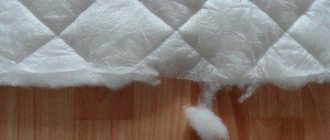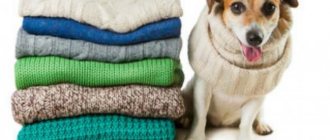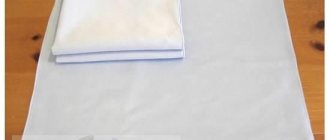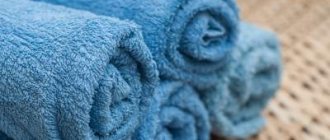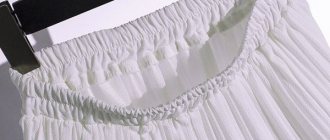Manufacturing process
The production of artificial fabrics began at the end of the 19th century.
And it has remained virtually unchanged to this day. The raw materials are crushed, boiled in alkali, bleached and pressed. Next, the resulting substance is transported to factories to form the final product. The thread production process includes four stages:
- Obtaining a spinning solution.
- Pressing the substance through a special plate (spinneret) into an acid bath - this is how threads are formed.
- Next comes the finishing stage.
- The drying stage is the final one.
Rules for drying and ironing
It is prohibited to dry viscose in a washing machine. Also, do not hang products on heating devices or in the open sun.
The best choice for fabric is to choose a horizontal arrangement. To do this, spread a terry towel on a flat surface, and place a wet item on top of it. At this stage, it is important to straighten the product well so that there are no creases left on it.
You can speed up the drying process by placing another terry towel on top of the item of clothing. Gently press it with your palms so that excess moisture is absorbed into the towel. After this, it is removed, allowing the viscose to dry further.
During the ironing process, you must act very carefully so as not to spoil the item. Viscose should be ironed according to the following principles:
- at minimum heating temperature;
- from the wrong side;
- through additional fabric.
If not all wrinkled areas can be straightened out, the material needs to be moistened. Viscose cannot be steamed.
Methods
Option #1
Let's consider it.
- Set the washing machine to exactly 60 degrees and wash your clothes.
- The spin mode should be standard.
- Let dry at the highest possible temperature. Of course, if your washing machine has such a mode.
Option No. 2
For example, you have a cotton dress and you have lost 1 size. Clothes can be made smaller by alternating high and low temperatures. If the clothes are clean, then the procedure can be carried out without powder.
The instructions include several steps.
- The dress should be soaked in water close to boiling water.
- After the water has cooled, you can wring out the item.
- Pour cold water with ice into a basin and throw the clothes in there.
- 20 minutes will pass, after which wring out the clothes a little and place them on a large towel (clean).
Do not throw synthetics or silk into boiling water.
Option #3
How to wash an item so that it fits 1 size? Modern irons have a device for releasing steam.
- Set your iron to maximum. Let it heat up.
- Iron, for example, a dress using steam.
Let's act tougher
If following the simplest tips you cannot save a viscose item, you will have to resort to “improved” methods. Experienced housewives advise not to get upset, but to adopt backup options.
A solution of soda, table vinegar, a hair dryer, or a weight suspended from the hem can help return the shape of a shrunken viscose item.
You can try to return the product to its original appearance.
- Prepare a solution of soda (in proportions of 1 tsp per glass of water), moisten a piece of gauze in it. Then you should put a gauze cloth on your clothes and run an iron over it with a steam generator setting.
- Moisten the item in clean water, then treat it with a similar soda solution. Next, you need to roll a viscose blouse or dress into a tube and carefully pull its edges. Then the thing unfolds and twists again, but in the opposite direction. The stretching procedure is repeated. At the end of the manipulations, the product should be rinsed and dried.
- Take a cotton sheet and wet it with a soda solution (one teaspoon of soda per 300 ml of water). The sheet is placed on a horizontal surface and straightened out. The shrunken viscose item should be placed on the canvas and covered with the free edge of the sheet. Wait two hours, then rinse the clothes and dry them.
- Stretch the completely dampened viscose sweater over the back of a chair, box, and dry with a hairdryer.
- Use a weight. This method is suitable when the item has decreased in length. If the hem is shortened, the bottom of the underwear is “grabbed” with an elastic band, where a light weight (400 grams) is then hung. Similar actions can be performed with shrunken sleeves or shorter trousers. In this position, the item can hang for a maximum of an hour, otherwise the bottom will stretch too much and be uneven.
- Moisten the viscose with a vinegar solution (100 ml of vinegar and half a liter of water). The item should be stretched out on a hard surface and secured on four sides with heavy objects. After 30 minutes, you need to rinse the product.
If you don’t want to “tinker” with a shrunken item, it is better to take the item to a trusted dry cleaner. Competent specialists can stretch clothes to the desired size, while maintaining their shape and brightness.
Types of viscose fabrics
The characteristics of the material depend on the added fibers. Varieties of viscose are also associated with this property.
It can be soft to the body, easily draped “soft viscose”, “Turkish”. More dense - “heavy viscose” and “stretch viscose” - with elastane or “dress” - with less stretch.
The type of crepe viscose is interesting - thanks to the special twisting of the threads, the surface of such material is rough and unusual.
Also interesting is the type of modal - it is made from beech and eucalyptus wood. The thread is the same, but two types of weaving allow you to create completely different fabrics:
- One-sided - almost silk surface, ideal smoothness.
- Double-sided - with terry pile, reminiscent of soft velvet to the touch.
Viscose can be heavy, weightless, smooth or textured. The basis of this diversity is natural and synthetic additional components.
What to do if there is heavy soiling on viscose clothing?
What to do if severe stains have formed on viscose clothes? How to deal with them? In this case, you will have to resort to pre-soaking.
To do this, add warm water to a bowl of water and add hand wash detergent, which is optimal for this type of fabric. You will have to soak the dirty item for half an hour.
And only after that, proceed to the main wash: manually or in a washing machine, so that the contaminated item does not shrink.
Caring for clothes made from viscose fabric involves more than just careful washing. Even a properly washed item can be ruined by drying it on a radiator or in direct sunlight. After washing the product in a delicate cycle or by hand, it should be laid out horizontally or wrapped in a roll in a terry towel to absorb moisture. Then the clothes can be hung on plastic or wooden hangers.
It is necessary to exclude any alkaline and bleaching agents; it is advisable to prefer liquid detergent to powder. Dry cleaning allowed. Washing, drying, ironing and even wearing things should be done with caution. This will preserve the appearance of the product and extend its service life. We described in detail the properties of this material in the article “Artificial viscose”.
Read the label on how to properly wash wool clothes. Now do the opposite.
- For example, soak it in hot water for no more than 30 minutes. This may be 20 degrees more than what is written on the tag.
- Now rinse your clothes in cold water. You can even do it with ice.
- Take a large terry towel and wrap your clothes in it. This will remove excess moisture.
- It is forbidden to twist heavily woolen items.
- You need to dry it on a flat horizontal surface. It is very convenient to do this with a hairdryer, simultaneously giving the item the desired shape so that it does not stretch during the drying process.
Advice! If you need to make a wool hat a size or two smaller, then find a salad bowl of the required shape (round). Pull the hat over it and dry it with a hairdryer or leave it to dry naturally.
Woolen jackets and other items washed in a machine shrink greatly, but you cannot control the process. If your sweater is plain, you can set the “wool” mode and try it. And then dry as described above.
Whether a wool sweater was initially baggy due to the wrong size, or whether the sleeves and edges have stretched out over time, it can all be corrected. You can make your clothes shrink by performing a few simple manipulations with them:
- Wash woolen items in hot water at a maximum temperature of 20 °C higher than the recommended temperature. Baby laundry detergent is best used as a laundry detergent. It will help maintain the structure of the fibers. The spin speed should not be more than 500-600 rpm.
- After washing, the product should be rinsed in water at a temperature of 40 °C mixed with a capful of fabric softener.
- Then rinse it again in water at a temperature of 50 °C, but without additives.
- For woolen products, contrast rinsing is also relevant, in which immersion in hot water can be alternated with soaking in ice water.
We suggest you read How to reduce font size on your computer
Recommendations
you keep viscose items in excellent condition :
Sorting viscose products before washing is a prerequisite for successful processing.- The best way to machine wash is using a mesh bag.
- To dye viscose, dyes designed for processing natural linen and cotton can be used.
- The use of home recipes for washing is possible with reservations, since the use of vinegar, ammonia, medical alcohol and a number of other substances for processing viscose is unacceptable.
- Placing items made of viscose in the drum of a washing machine together with items made of coarse fabric (jeans, jackets, etc.) is unacceptable.
- For bleaching, you can use oxygen-containing preparations approved for washing viscose.
- If the percentage of viscose in a mixed material is very small, care rules should be chosen in accordance with the type of base fabric.
Despite following all the rules for caring for things, viscose can shrink. This happens, as a rule, with low-quality fabrics that contain other fibers in addition to viscose.
You will find maximum useful information about washing clothes and various fabric products here.
Advantages and disadvantages of viscose fabric
We discussed the qualities of viscose without additional fibers above. However, viscose manufacturers have achieved that fabric made from cellulose fibers can be either matte or shiny. Can stretch and may be completely inelastic. Such indicators are typical for additional additives in raw materials.
- There is no accumulation of static electricity.
- The fabric is hypoallergenic.
- The term thermolabile can be used to combine three qualities - breathability - allows the body to breathe, thermal conductivity - retains heat in winter, cools in summer, hygroscopicity - easily absorbs moisture.
- Very pleasant to the body.
- Retains color and shape for a long time, with proper care.
- Drapes beautifully.
- Easy to dye, does not lose color when washed.
Flaws:
- High creaseability.
- Requires special care.
- Loses its appearance from ultraviolet radiation.
- When wet, the strength index decreases.
The areas of application of viscose are incredibly diverse. From textile fabrics to bactericidal and high-strength modifications. It is used both in the production of textiles and in the production of racing tires.
Considering the application in the textile industry, the variety of weaves, dyeing quality, structure and density of the fabric give an incredible range of applications. From the finest knitted underwear to dresses and suits with exquisite texture. Viscose is also used to make toys, home textiles, and used in shoe production.
Cotton products
If cotton clothing needs to be reduced in size, it should be machine washed in hot water. After adjusting the temperature on the washing machine, you need to set the temperature to more than 40 °C. If shrinkage by one or two sizes is required, the temperature should be set to the highest.
Cotton fabric stretches and contracts during the manufacturing process. When it heats up, the tension in the filament decreases, causing it to shorten. Heating can successfully shrink almost anything. You need to use the longest wash cycle. High temperature along with water and cycling will be very effective.
To significantly shrink the item, you can put it in boiling water and hold it there for 10-20 minutes. The duration of the procedure promotes greater shrinkage. After boiling, the product must be rinsed in cold water.
Practice shows that a cotton T-shirt stretches even faster than a wool sweater. But even in this case, it is possible to adjust the shape of the thing. It is worth considering that when working with cotton, restoration is only possible if the clothing was sewn correctly. If the threads are located and directed incorrectly, then nothing can be done.
Cotton products give maximum shrinkage in the following cases:
- Machine wash using very hot water and maximum spin.
- The product can simply be dipped in boiling water. True, even a short stay of a colored product in such hot water can provoke it to shed. But just five minutes of treatment will reduce the item by size, a quarter of an hour in boiling water and the clothes will become 1.5-2 sizes smaller.
- If you don’t want to risk the color of the item, then it is better to wash it in the traditional way, and then put it in an electric dryer.
We evaluate the result based on the completely dried product. If you can't do anything the first time, you shouldn't even try again. The positive effect most likely will no longer occur, but the item will ultimately be damaged. In this case, you will have to contact a studio or update your wardrobe.
Need to shrink a cotton cardigan? This will work if it is sewn correctly. If the threads do not go as required, then nothing will work.
How to shrink a large cotton dress or suit? Experts recommend setting the machine to the hottest water possible with a strong spin. But you can only wash white clothes this way.
It is better to wash colored clothes by hand. Moreover, you need to remember the rule: when kept in boiling water for 5 minutes, the item decreases by 1 size. Accordingly, if you keep it in boiling water for 15 minutes, it will decrease by about 2-3 sizes.
After hand washing, it is advisable to use an electric dryer. If even after these actions the item has not decreased significantly, repeating the procedures is useless.
Nothing can be done. The clothes will remain the same size, but the structure of the fabric, especially colored ones, can be damaged by hot water.
Machine washable
Only items made of dense material can be loaded into the drum of the machine, for example: blankets and jackets made of quilted viscose, T-shirts and tracksuits. Machine washing is carried out in the following sequence:
- The prepared items are placed into the device in the usual way or in a special mesh bag.
- A specialized product and conditioner are poured into the ditch. If stains need to be removed, add oxygen bleach according to the instructions.
- On the panel, select the “delicate wash” or “hand wash”, “wool” or “synthetic” mode.
- For particularly delicate products, the temperature is set to 30°. Thicker items are washed at standard 40°.
- To reduce the mechanical impact on matter, it is advisable to disable the “spin” option. “Drying” is excluded unconditionally.
Under no circumstances should ribbed laundry balls be placed together with viscose products. There will be puffs and possibly tears in the fabric.
We wash polyester and other synthetics
Unlike viscose, polyester is a synthetic material made from petroleum products. It is electrified and is contraindicated for people with allergic reactions and skin diseases.
How to distinguish viscose from polyester:
- Viscose has a pleasant, delicate sheen; polyester has more of a metallic sheen.
- The viscose material is soft and flowing. Synthetic fabrics are not as comfortable to the touch.
- Polyester is durable and strong, resistant to tearing.
- Cellulose fibers are easy to cut with scissors, without effort, but polyester fibers are much stronger, and cutting such material is more difficult.
- Synthetics melt if set on fire, viscose burns, leaving gray ash.
- Polyester is resistant to bleaching and boiling.
- Synthetic items are easier to care for - the fiber is solid, elastic, has no pores and does not absorb dirt. Therefore, it is much easier to remove stains from synthetics.
It is quite difficult to unequivocally answer the question of what is best for a child. Each parent decides this for himself. Both cotton and viscose have the same qualities of hygroscopicity and breathability.
Both types of materials have a natural fiber base. The only difference can be that viscose is still an artificially created fabric.
Modal is a type of viscose fabric that was previously discussed in this article. It is made from the cellulose of specific tree species, without the use of chlorine in the process. Its properties and characteristics are the same as those of other cellulose-based materials.
We suggest you familiarize yourself with How to dry apples and other products in an air fryer: 5 best step-by-step options
Cellulose is the basis of viscose fiber. The raw material from which the thread is made. Therefore, the main difference is the physical properties. Cellulose is fiber, viscose is a thread consisting of them.
Viscose or kulirka
Some sources claim that the kulirka is 100% knitted cotton fabric. However, this is not quite true. Kulirka is a special weaving that makes the fabric light, stretchable and easily returns to its original shape. In this fabric, loops are intertwined, not threads, as in other fabrics. This weaving is also called "stocking stitch". But any thread can be used for its production, including viscose.
Acrylic or viscose
Acrylic, like polyester, is a synthetically synthesized fiber. Produced from natural gas through complex chemical reactions. It does not absorb moisture and retains heat in severe frost. Unlike viscose, acrylic is ideal for the production of outerwear.
Remember that lycra with acrylic and spandex, polyester are not made smaller. If you need to significantly reduce your shirt, go to a tailor or buy other things. For example, a atelier can make a shorter spandex blouse. Entrust this to specialists, because you can ruin synthetics yourself.
Work with denim is carried out only if it contains cotton. In this case, all responsibility for the result again lies with hot water. We soak the product in a liquid whose temperature should not exceed 60ºC, otherwise the color of the material will begin to wash out. After the water has cooled, wash the items as usual, trying to rub as little as possible.
To reduce the size of a silk product, it is enough to hold it in warm water, the temperature of which will be within the maximum permissible limits. After which the item dries naturally.
Polyester and nylon will shrink noticeably if you simply wash them in cold water. It is better to dry them in a washing machine at high speed. Otherwise, the product will have to be dried directly on the radiator.
Acrylic, spandex and lycra products cannot be reduced by chemical or physical influences. Their size can only be changed by altering the item. But if such materials have already stretched, then it will be very difficult to restore the original shape of the product.
Is it always possible to correct the situation if the thing is stretched out?
It is not always possible to return a stretched item to its original state:
- It is unlikely that an acrylic pullover can be restored; this material is prone to stretching.
- Synthetic fibers shrink much less than natural fabrics. For example, polyester does not shrink. And if synthetic fiber is introduced into the composition of natural fabric, even in a minimal amount, then this immediately affects its properties: the degree of shrinkage will decrease.
- Woolen items undergo significant changes as a result of washing: they can stretch in whole or in part. For example, out of the entire item, only one sleeve may be deformed. Most often this is a consequence of improper tailoring of the product.
- Clothing made from a mixed composition of wool blend threads will behave depending on the composition. For example, the combination of wool and acrylic does not shrink.
- Linen gives a high degree of shrinkage, this property is especially aggravated under the influence of high temperatures.
- Products containing 100% cotton always shrink after washing and can shrink by 1-2 sizes.
- Jacquard can contain different fibers: natural and synthetic. To understand the amount of shrinkage of such fabric, you need to carefully study its composition. If cotton or linen is present, it means that the jacquard item may shrink after washing.
- An item containing viscose may become smaller in size after washing.
Video: what things shrink and why
Proper fabric care
Viscose is practically never found in 100% fabric, but even in small proportions, it suffers from excess alkali. Therefore, it is important to choose the right detergent for delicate washing. The temperature at which viscose items will not lose their properties and shape is about 30°C.
When cleaning, you should also carefully read the instructions on the label. Since viscose fiber loses its strength when wet, and a mixed composition can give an unexpected result, a special approach must be taken to washing.
Machine washable
The “delicate” mode is used, without spinning. In this case, you should use special laundry bags and try to place fabrics of the same texture in the drum.
Handwash
This is the most gentle way to wash fabric. The product is placed in water with powder for half an hour, and then washed with light massage movements.
First of all, you must follow the instructions for the product. Most often, it contains comprehensive information regarding the temperature at which the thing does not deform.
Most often, a piece of fabric is washed before cutting in order to examine its properties in detail. Does the fabric lose color, texture, or shrinkage? This is an important stage in tailoring. Viscose fiber, in itself, holds color very well and does not lose its shape. Therefore, the determining factor will be the composition of the fabric - washing is required if there are natural fibers.
There are cases when clothes made of viscose with the addition of natural fibers stretch. In this case, you can return the items to their original appearance by increasing the temperature of the water when washing, then gently wring out the water and, laying the item on a towel, give it the desired appearance with your hands. If a product with an additive such as elastane has stretched, increasing the water temperature can only aggravate the problem.
Like any other natural fiber, cellulose has a porous structure. If you want to starch your underwear or shirt, the material allows you to do this. Everything happens in the same way as with natural fabrics - the product is placed in water with starch, dried, and ironed.
Whitening
To maintain the brilliant white color, viscose products can be periodically bleached. For this purpose, products with an oxygen bleaching component are used. Chlorine-containing bleaches will ruin the item.
Drying and ironing
After washing, carefully wring out the product, lay it on a towel, roll it up, and wring it out again. Next, the item needs to be laid out on a flat, horizontal surface, giving it its original shape. Ironing occurs on a damp cloth, from the inside; if the item is dry, then use wet gauze. It is not recommended to steam such things, nor to use a spray bottle - marks may remain. Temperature: “silk”.
Sometimes a product made of viscose wrinkles a lot. This disadvantage can be dealt with in two ways. Starch as described earlier. Or crash (from English crash-destroy). After washing, it is necessary to twist the wet product into a tight rope and leave to dry. Creases and bruises will add charm and a touch of charm.
This means it contains flax or wool. Not all of them can be treated with chemicals - various softening rinses. Unfortunately, some fabrics cannot be “tested” in advance and the defect becomes noticeable only the first time the product is used. In these cases, thin underwear is worn under the clothes or a lining of another material that is pleasant to the skin is sewn on.
Reasons for product shrinkage
Before washing viscose clothes, you must carefully study the information on the label. As a rule, it contains detailed information about washing, drying and ironing the product. Before washing viscose items, you should:
- Perform sorting. Despite the fact that clothes made from this material are highly colorfast, they may fade. To prevent clothes from getting damaged, it is important to group light-colored laundry with white, and wash black and colored laundry separately.
- Check your pockets. Before washing viscose, it is recommended to make sure that there is no money, chewing gum, or bus tickets in your clothing pockets. Foreign objects can not only damage the automatic machine, but also lead to a change in the color of the material.
- Fasten the zippers and buttons. This helps the garment keep its shape and prevents it from shrinking.
- Turn inside out. Any things should be turned out first. This way they will remain fresh and attractive longer.
Clothes may become a couple of sizes smaller if:
- sharp temperature changes were observed during washing and rinsing;
- the product dried near heating devices or in the sun;
- used too hot water;
- During the spin cycle, the machine was set to high speed;
- products with alkali were used;
- the product was steamed with an iron.
Washing jeans
Regular denim items can be reduced by a size by washing them in very hot water. The fabric will fade a little and the water will turn blue or black, but this is not critical. But you won’t be able to shrink a stretch denim item. They even have a “shrink to fit” label on them.
When washing in a washing machine, set the temperature to between 60 and 90°C. The maximum spin is required. Drying can be done by machine, or simply hang things on a very hot radiator.
We suggest you familiarize yourself with Warm floors: which one is better to choose, which one is more economical
When washing by hand, alternate between very hot water and ice water. Then the thing will definitely decrease in size.
Unfortunately, jeans can become not only narrower, but also shorter. This nuance must be taken into account.
In the washing machine
Machine washing viscose allows you to tidy up and refresh your item without effort. To ensure that the product itself is not damaged and maintains its appearance, you need to carefully set all the settings.
Procedure:
Prepare your own things.- Place viscose products in the drum of the machine.
- Pour detergent into the special compartment on the machine.
- Set to “delicate” or “hand wash” mode.
- Make sure that the temperature is set no higher than +30ºС.
- Disable spin.
- Start the wash.
After washing, all items must be immediately removed from the drum and sent to dry. If this is not done, the fabric will become very wrinkled and may acquire an unpleasant, stagnant odor.
This video will show you how to wash viscose in a washing machine:
Viscose carpets
Viscose carpets come in a huge variety of colors, sizes and shapes. They are cheaper than carpets made from natural threads, and their advantages and disadvantages are the same as those of viscose fiber.
Cellulose carpets are non-allergenic, do not accumulate static electricity, are light, soft and pleasant to the touch. The disadvantages of such coverings are the complex process of getting rid of dirt - experts recommend cleaning them in a dry cleaner, where they will select a special gentle cleaning agent for your carpet. In addition, these carpets are resistant to moisture and wet spots.
Even if plain water is spilled on the carpet, the stain will be very noticeable after drying.
As an alternative to viscose, polypropylene carpets are produced. They do not cause allergies, are more resistant to stains, are not afraid of moisture and are easier to clean. Unlike viscose ones, they can be used in the bathroom and hallway. However, they are less resistant to deformation and their service life is significantly shorter than that of cellulose. Dyes in polypropylene are not afraid of ultraviolet radiation.
Both carpet options are acceptable in price, quality and appearance. However, viscose requires more thoughtful care and cleaning.
Preparation for the process
At the stage of preparation for washing you should:
- study the product label;
- check your pockets and remove all unnecessary items from them;
- fasten all fasteners;
- turn the item inside out.
Mode and spin
Like other delicate materials, viscose can be washed in one of the following modes:
- "delicate";
- "handwash".
Intense exposure should be excluded. Otherwise, the item may be seriously damaged. Therefore, “spin” should be turned off to avoid deformation of the fabric.
At what temperature, by what means?
The fragility of viscose fabric imposes restrictions not only on the intensity of processing, but also on the heating temperature of the water. The maximum permissible is +30ºС. If the water is hotter, things will shrink.
When choosing a laundry detergent, there are a number of factors to consider. These include restrictions on water temperature. This is important because some detergents only perform well at higher temperatures.
It is best to use those designed for processing delicate fabrics. The gel form is preferable to the powder. The use of washing powders and gels that are not intended for delicate materials can lead to damage to items.
Using conditioner during the final rinse will make the item softer.

